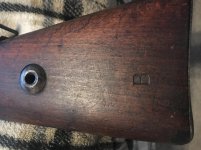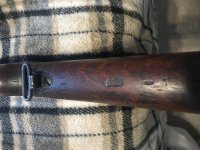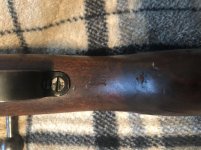Bob in OHIO
Senior Member
Sure, the "B" designates beech, but why (was that important)? And, was the B stamped when the Imperial cartouche was stamped or before? I understand the what, just not the why.




Sure, the "B" designates beech, but why (was that important)? And, was the B stamped when the Imperial cartouche was stamped or before? I understand the what, just not the why.
My guess is because the Germans didn't expect to lose the war and the Army wasn't overjoyed with the use of substitute woods...
..with beech stock monitored to see how they behaved under use in a variety of roles. If a rifle came back to a ordnance center it could be recorded and reported to the proper authorities monitoring the issue.
I personally dislike it as a collector, as it doesn't take on the awesome patina that well-seasoned walnut does. It doesn't hold inspection stamps well either, they tend to be blurry and indistinct.
No mention of the mythical (?) 'A' maple stocks, or the 'R' elm stocks?
CB is sorely missed, and Bill needs to get his a$$ back to collecting, or at least paying attention to it.
I agree, beech is not desirable to me either, often the acceptance stamps are next to impossible to decipher.
The other substitute wood are so rare as to deserve the reputation as mythical... Mauser seems the only to have used them and very rarely. R is practically a myth outside of Storz, though I have seen "R" marked once, not even sure if it is the mythical elm.
** couldn't find the picture of the "R", though I did find "E", supposedly for oak? PeterK rifle, he didn't show much of the rifle and his datasheet is not helpful in regards to the stock origins. Said serialed to match the Danzig/05 it hosts, but obviously this can't be if this is one of the substitute woods. CB suggested the possibility it is oak, but who knows... BiO is a "man of the wood", maybe he can offer his opinion? Personally, considering the stock has no grips or takedown it doesn't seem likely the E=Eiche, but I learned to be careful questioning CB many years ago!
IIRC, Bob sent some wood samples to the Forestry Service some years back....
Starting from the "Austrian approach" ... Austria also used various types of wood on the M.95 rifle. And this was not started with WWI, but started with the M.95 from its first day and it was more than just two types. Therefore these were always designated with a single letter in front of the magazine guard. I'm at least aware and have seen the following:
"A" for "Ahorn" (Maple)
"K" for "Kastanie" (Chestnut)
"N" for "Nuss" (Walnut)
"R" for "Rüster" (Elm)
... there were also experiments with laminate wood and Birch being done. Documents also mention crude trials with tropical wood which once had been at hand. However, once the stock has been finished, it is (aside of the Elm) very hard to tell without reading the letter which type of wood it is since they were most often also stained to look like walnut.
Comparing this to Germany who used from the beginning only Walnut and therefore it was not necessary to mark them as being Walnut. To my knowledge Beech stocks started appearing with WWI, which means it was used as replacement for the lack of Walnut. Of course you then don't start marking the existing rifles too. Therefore I assume this was simply to see if any type of wood would result in problems in the field, rather than to replace these all later. I mean we would encounter much less B marked stocks nowadays, if this had been the case.
..the "E" marked stock is certainly not oak.

